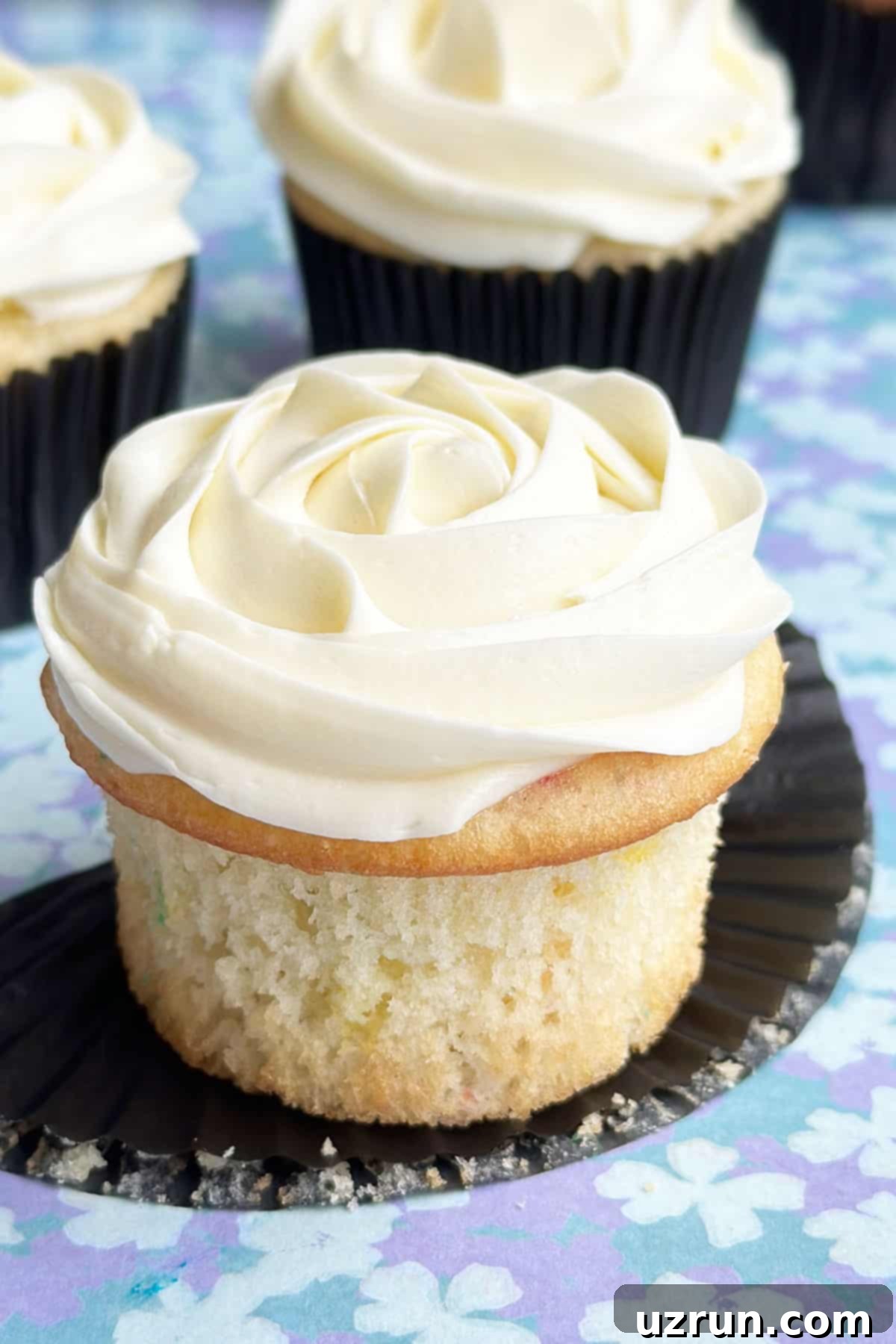Deliciously Moist & Easy Almond Cupcakes with Creamy Almond Buttercream (WASC Recipe)
Prepare to fall in love with these incredibly soft, moist, and effortlessly easy almond cupcakes! This delightful recipe features a tender crumb, bursting with fragrant almond flavor, and is crowned with a luxurious homemade almond buttercream frosting. Often known as White Almond Sour Cream (WASC) cupcakes, this classic method ensures a consistently perfect result every time, made simply with readily available ingredients. Whether you’re a seasoned baker or just starting, these cupcakes are guaranteed to become a new favorite in your repertoire.
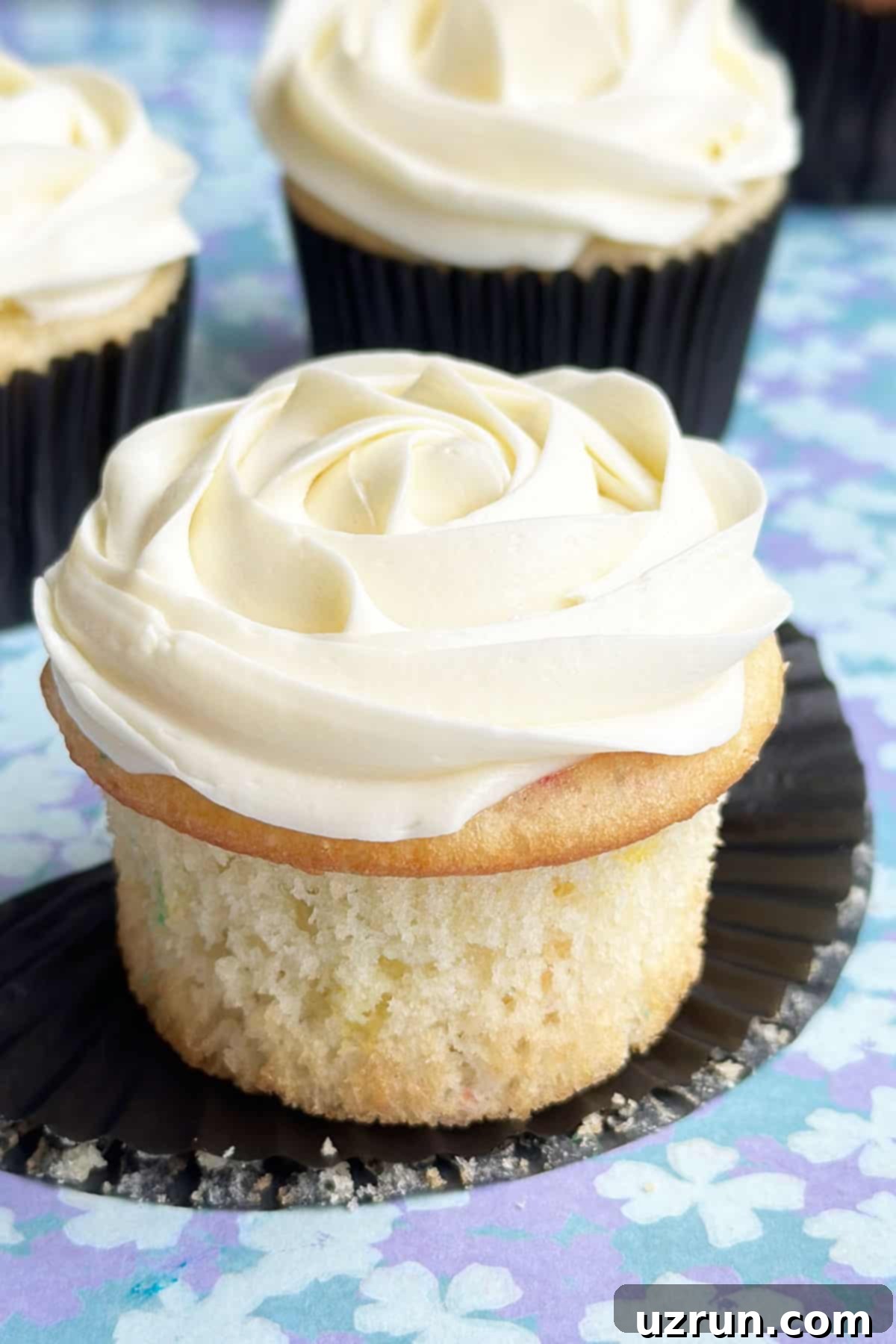
My journey to perfecting these almond cupcakes was an enlightening one. The very first time I attempted an almond cupcake recipe, I was determined to amplify the almond essence by using almond flour. While the intention was good, the result, unfortunately, was a disaster! The cupcakes were incredibly dense and oily, far from the light and airy texture I envisioned. It was a crucial lesson learned: for a truly soft and fluffy crumb, good old all-purpose flour is the way to go, and I highly recommend you stick to it too. From that point onward, my focus shifted to achieving that signature delicate texture while infusing a robust, yet balanced, almond flavor.
Speaking of almond flavor, it’s worth noting that almond extract is remarkably potent, and its intensity isn’t for everyone. For instance, my son tends to scrunch his nose at the aroma, but I, along with the rest of my family and friends, adore them! If you, too, cherish the distinct taste of almond, you’ll definitely want to explore some of my other almond-infused delights. Try my Almond Crescent Cookies for a buttery, melt-in-your-mouth experience, my chewy Italian Almond Cookies, or the delightful crunch of Banana Almond Biscotti. Each offers a unique way to enjoy this wonderful flavor.
[feast_advanced_jump_to]
Key Ingredients for White Almond Sour Cream Cupcakes (WASC)
Creating these heavenly White Almond Sour Cream (WASC) cupcakes relies on a careful selection and preparation of key ingredients. Each component plays a vital role in achieving their characteristic moist, tender, and flavorful profile. Here’s a closer look at what you’ll need and why:
- Egg: A large egg is essential for structure and binding. Using it at room temperature ensures it emulsifies more easily with other ingredients, creating a smoother, more uniform batter and contributing to a lighter texture in the final cupcake.
- Oil: Vegetable or canola oil is preferred for its neutral flavor, allowing the almond to shine. Oil is superior to butter in some cupcake recipes for providing exceptional moisture and a tender crumb that stays soft for days.
- Sour Cream: This is the secret star of WASC cupcakes! Full-fat sour cream adds incredible richness, moisture, and a subtle tangy note that balances the sweetness. Its acidity also works with baking soda to help the cupcakes rise beautifully. Make sure it’s at room temperature for optimal mixing.
- Water: Lukewarm or room temperature water is best. It helps to bring the batter to the right consistency without shocking the other ingredients, ensuring a smooth mix and even baking.
- Vanilla and Almond Extracts: These extracts are the heart of the flavor. Vanilla extract provides a comforting base note, while almond extract delivers that distinctive, aromatic almond essence. The key is to balance them, remembering that almond extract is quite potent, so start with a smaller amount and adjust to your preference.
- All-Purpose Flour: Sifting your all-purpose flour is a crucial step! It aerates the flour, removes any lumps, and ensures a more accurate measurement. This leads to a finer, more tender crumb in your finished cupcakes. Avoid substituting with almond flour, as it will result in a dense and oily texture in this particular recipe.
- Granulated Sugar: Standard white table sugar provides sweetness and helps to tenderize the cupcakes. It also contributes to the beautiful golden-brown color during baking.
- Baking Powder and Baking Soda: These are your essential leavening agents. Baking powder provides initial lift, while baking soda reacts with the acidic sour cream to create additional carbon dioxide, resulting in fluffy, well-risen cupcakes. Ensure both are fresh for the best results.
- Almond Buttercream Frosting: You’ll need at least 2 cups of this creamy, dreamy frosting to generously top your cupcakes. Its rich, buttery texture and complementary almond flavor are the perfect finish to these delightful treats.
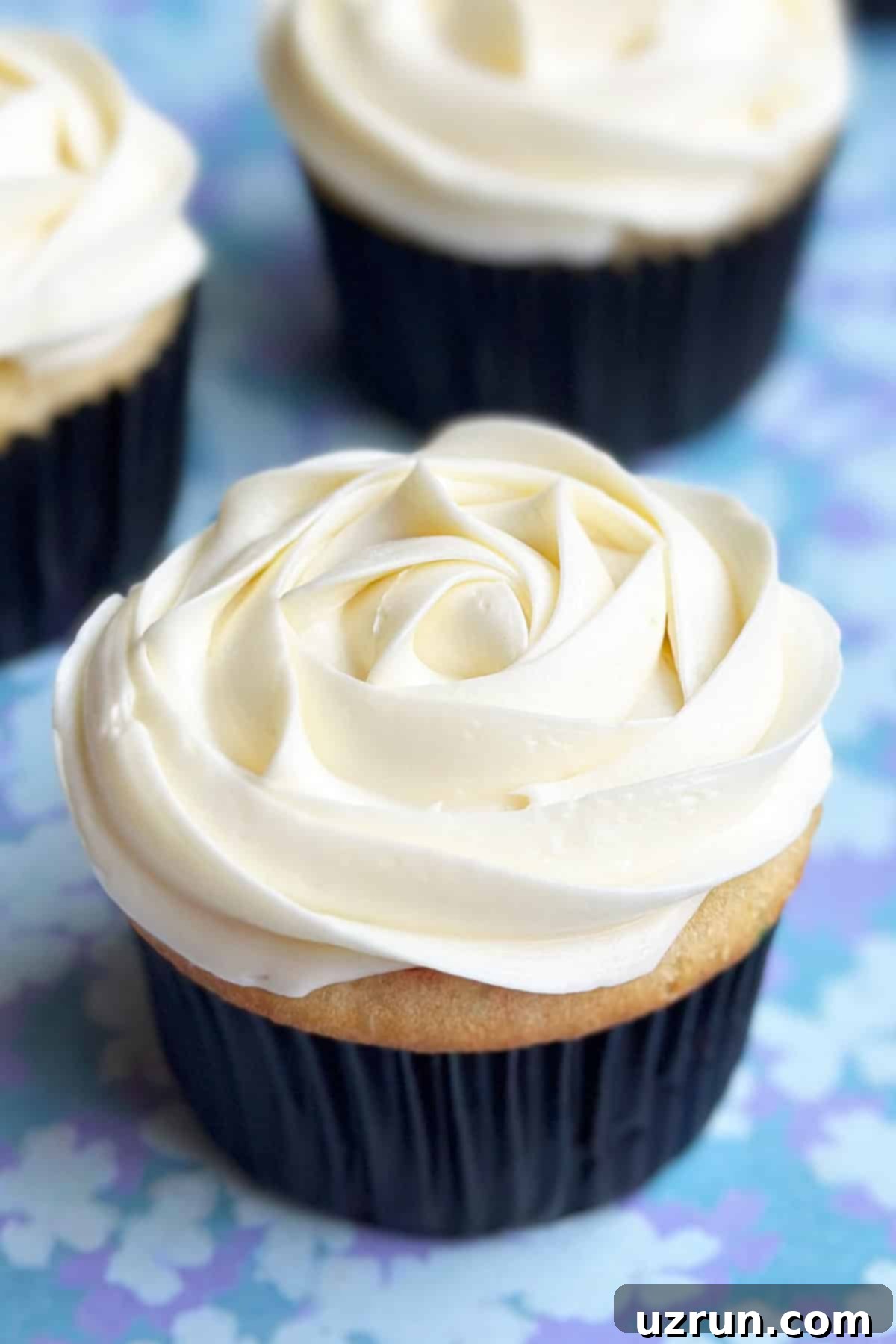
Creative Variations for Your Almond Cupcakes
While these almond cupcakes are perfect as is, they also serve as an excellent base for various flavor combinations and decorative enhancements. Don’t be afraid to get creative and customize them to your liking!
- For a Chocolate Almond Version: Elevate the classic chocolate cupcake by infusing it with almond. Simply whip up my Best Chocolate Cupcakes recipe and add a touch of almond extract alongside the vanilla. The almond beautifully complements the deep cocoa notes, creating a sophisticated flavor profile.
- If You Prefer the Cake Mix Route: For a quicker approach, start with a white cake mix. Follow the package instructions, but enhance the flavor by adding 1 teaspoon of pure vanilla extract and a hint of almond extract (¼ to ½ teaspoon, depending on preference) to the batter. This trick significantly upgrades a basic box mix!
- Explore Other Frostings: The almond flavor in these cupcakes pairs wonderfully with a variety of frostings. My Maraschino Cherry Frosting, which already boasts a hint of almond, would be a fantastic choice, offering a fruity and nutty combination. You could also try a classic American Buttercream, a rich Caramel Frosting for a decadent twist, or a vibrant Blackberry Buttercream Frosting for a fruity contrast.
- Perfect Your Decorating Skills: If you’re new to cupcake decorating, these are a great canvas. Check out my comprehensive post on How to Decorate Cupcakes (Pipe or Frost Cupcakes) for step-by-step guidance on piping beautiful swirls and roses.
- Delightful Batter Add-ins: Introduce exciting textures and flavors directly into the batter. Consider adding regular or mini chocolate chips, white chocolate chips, finely chopped nuts (like pecans or walnuts), or even dried cranberries. For tips on how to prevent ingredients like chocolate chips from sinking to the bottom, refer to my post on How to Stop Chocolate Chips From Sinking.
- For Truly White Cupcakes: If your goal is a pristine, pure white cupcake, you might want to try my White Wedding Cupcakes. They offer a similar elegant flavor profile to these WASC cupcakes but are specifically designed for that bright white appearance, often achieved by using only egg whites and clear extracts.
- Create Filled Cupcakes (Stuffed Cupcakes): Add an extra layer of surprise and flavor by filling your cupcakes. Use a cupcake corer or a small spoon to hollow out the centers, then fill them with delightful additions like homemade Strawberry Jam, creamy Strawberry Frosting, rich Cherry Pie Filling, tangy Raspberry Pie Filling, or luscious Caramel Sauce. These fillings beautifully complement the almond flavor.
- Add Coloring to the Batter: For a fun, festive, or thematic touch, incorporate gel food coloring into your batter. Gel colors are highly concentrated and won’t thin out the batter as much as liquid food coloring. Just a few drops can transform your cupcakes with a vibrant pop of color.
- Extra Decorations on Top: After frosting, the possibilities for decoration are endless! Enhance the visual appeal and add extra texture with a sprinkle of colorful sprinkles, toasted coconut flakes, finely chopped almonds, mini chocolate chips, crushed cereal, or even small candies.
How to Make Easy Almond Cupcakes from Scratch
Crafting these delicious almond cupcakes from scratch is a straightforward process that yields incredibly satisfying results. Follow these simple steps for perfect, bakery-style treats:
- Combine Wet Ingredients: In a large mixing bowl, thoroughly whisk together the room temperature egg, oil, sour cream, water, vanilla extract, and almond extract until the mixture is completely smooth and well-emulsified. This step ensures that all the liquid components are evenly distributed before introducing the dry ingredients.
- Incorporate Dry Ingredients: Gently add the sifted all-purpose flour, granulated sugar, baking powder, and baking soda to the wet mixture. Mix until just combined. It’s perfectly fine, and even desirable, to have a few small lumps in the batter. The most crucial rule here is to avoid over-mixing, as this can lead to tough, chewy cupcakes.
- Prepare for Baking: Divide the cupcake batter evenly among your prepared cupcake liners, filling each approximately two-thirds full. This allows room for the cupcakes to rise without overflowing.
- Bake to Perfection: Place the cupcake pan into a preheated oven and bake at 350°F (175°C) for 18-20 minutes, or until a wooden toothpick inserted into the center of a cupcake comes out clean. The tops should be lightly golden and spring back gently when touched.
- Cool Completely: Once baked, remove the cupcakes from the oven and let them cool in the pan for a few minutes before transferring them to a wire rack. Allow them to cool completely to room temperature. This is a critical step; frosting warm cupcakes will cause the frosting to melt and slide off.
- Frost and Enjoy: While the cupcakes are cooling, prepare your almond buttercream frosting. Once the cupcakes are fully chilled, fill a piping bag fitted with your favorite tip (a 1M large star tip works wonderfully for classic swirls or roses). Pipe a beautiful swirl or rose design on top of each cupcake. Serve immediately and savor every soft, almond-infused bite!
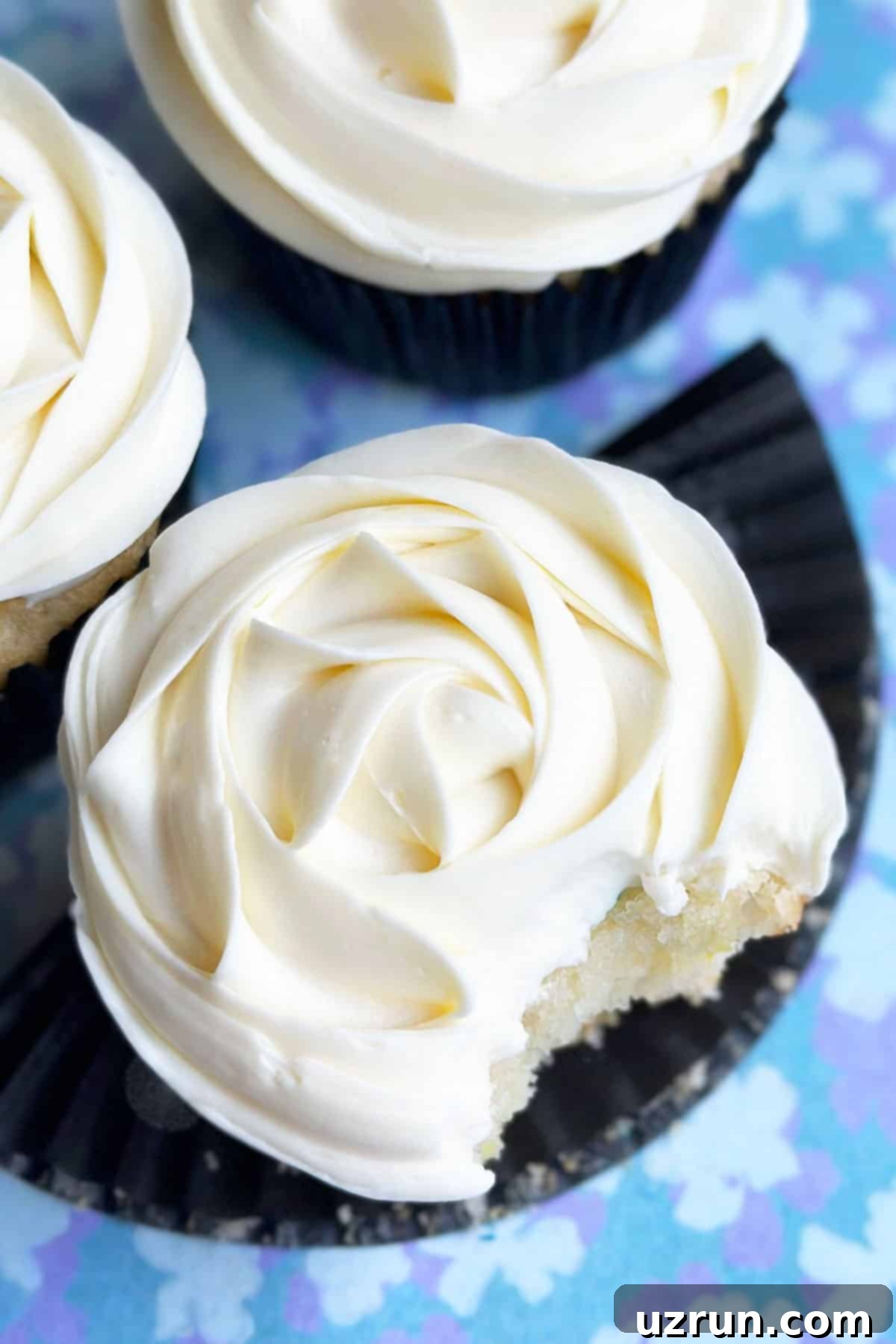
Essential Tips and Techniques for Perfect Almond Cupcakes
Achieving consistently perfect, bakery-quality almond cupcakes is easier than you think with these expert tips and techniques. Pay attention to these details, and your cupcakes will turn out beautifully every time:
- Ensure Fresh Leavening Agents: Always check the freshness of your baking powder and baking soda. Expired leavening agents are the most common culprit for flat, dense cupcakes. You can test baking soda by mixing a pinch with a drop of vinegar; it should fizz. For baking powder, mix a teaspoon with hot water; it should also fizz vigorously.
- Don’t Skip the Sifting: Sifting all-purpose flour is not just for removing lumps; it also aerates the flour, making it lighter and easier to incorporate. This leads to a smoother batter and a more tender, fluffy crumb in the final cupcake. It also helps in achieving a more accurate measurement, as packed flour can weigh more.
- Opt for Clear Extracts for Whiter Cupcakes: If a truly pristine white cupcake and frosting are your goal, use clear vanilla and almond extracts. Regular extracts have a slight brownish tint that can subtly darken your batter and icing.
- Avoid Over-mixing the Batter: This is arguably the most crucial tip! Over-mixing develops the gluten in the flour, resulting in dense, tough, and chewy cupcakes instead of the desired light and tender texture. Mix only until the dry ingredients are just combined, and a few small lumps are perfectly acceptable.
- Watch Your Baking Time Carefully: Over-baking is another common cause of dry cupcakes. Keep a close eye on your oven and start checking for doneness at the minimum recommended baking time. Cupcakes should be no darker than a light golden brown around the edges. Under-baking, on the other hand, will leave them doughy and sunken in the middle. The toothpick test is your best friend: insert a toothpick into the center, and if it comes out clean or with a few moist crumbs attached, they are done.
- Use Room Temperature Ingredients: This applies to eggs, sour cream, and even water. Room temperature ingredients blend together much more smoothly and easily, creating a uniform emulsion and a more consistent batter texture. This ultimately contributes to a better rise and a more tender cupcake.
- Stick to Full-Fat Ingredients: For the richest flavor and most luxurious texture, especially with sour cream, opt for full-fat versions. Low-fat alternatives can lead to a less moist and flavorful cupcake.
- Adjust Almond Extract to Taste: Almond extract is very potent. Start with the lower recommended amount (e.g., ¼ teaspoon) and then taste your batter (before adding eggs, if you’re concerned) or the finished product. You can always add a little more to the frosting if you desire a stronger flavor. Exceeding 1 teaspoon for a batch of 12 cupcakes can make the flavor overwhelming or even slightly bitter.
- Never Frost Warm Cupcakes: Patience is a virtue when it comes to frosting! If you try to frost warm cupcakes, the heat will quickly melt your beautiful buttercream, turning it into a gooey, runny mess. Ensure your cupcakes are completely cooled to room temperature, or even slightly chilled, before piping.
- Fill Cupcake Liners Properly: For uniform cupcakes, fill each liner about two-thirds full. This allows them to rise perfectly without spilling over the edges or being too small.
- Know Your Oven: Ovens can vary widely in temperature. Consider investing in an inexpensive oven thermometer to ensure your oven is truly heating to the temperature you set. This can prevent many baking mishaps.
Recipe FAQs for Almond Cupcakes
Got questions about these delicious almond cupcakes? Here are answers to some of the most common inquiries to help you master this recipe.
Dry cupcakes are a common issue, usually stemming from one of two main reasons: over-baking or over-mixing the batter. Over-baking causes too much moisture to evaporate, while over-mixing develops gluten excessively, leading to a tough, dry texture. Always watch the baking time closely and don’t be concerned if your batter has a few small lumps – a slightly lumpy batter is better than an over-mixed one! Using low-fat ingredients can also contribute to dryness.
No, absolutely not for this specific recipe. While almond flour is excellent in many gluten-free and low-carb baking applications, it behaves very differently from all-purpose flour. Substituting it directly in this WASC recipe will result in cupcakes that are disappointingly dense, oily, and lack the desired fluffy structure. This recipe is specifically formulated for the gluten structure provided by all-purpose flour to achieve its signature light and moist crumb.
Almond extract is incredibly potent, so a little goes a long way! For most cake and cupcake recipes, it’s best to start with a modest amount, typically ¼ teaspoon for a standard batch (like these 12 cupcakes). You can then gradually increase it up to ½ or even 1 teaspoon, tasting as you go, to suit your personal preference. However, I wouldn’t recommend exceeding 1 teaspoon for a full recipe of cupcakes or cakes, as too much almond extract can lead to an artificial, overpowering, or even bitter taste. Remember, if you’re also using almond extract in your frosting, that will add to the overall flavor intensity.
While full-fat sour cream is highly recommended for the best texture and flavor, you can try a few substitutions if absolutely necessary. Full-fat plain Greek yogurt or buttermilk can work in a pinch. If using Greek yogurt, thin it slightly with milk or water to match the consistency of sour cream. If using buttermilk, you might notice a slightly tangier flavor. Both options should be at room temperature.
Baking soda (sodium bicarbonate) is a base that requires an acid (like the sour cream in this recipe) to react and produce carbon dioxide, creating lift. Baking powder is a complete leavening agent; it contains both a base and an acid, along with a starch, and typically has a double-acting mechanism, meaning it reacts once when mixed with liquid and again when exposed to heat. Using both in this recipe ensures optimal rise and a perfectly aerated texture.
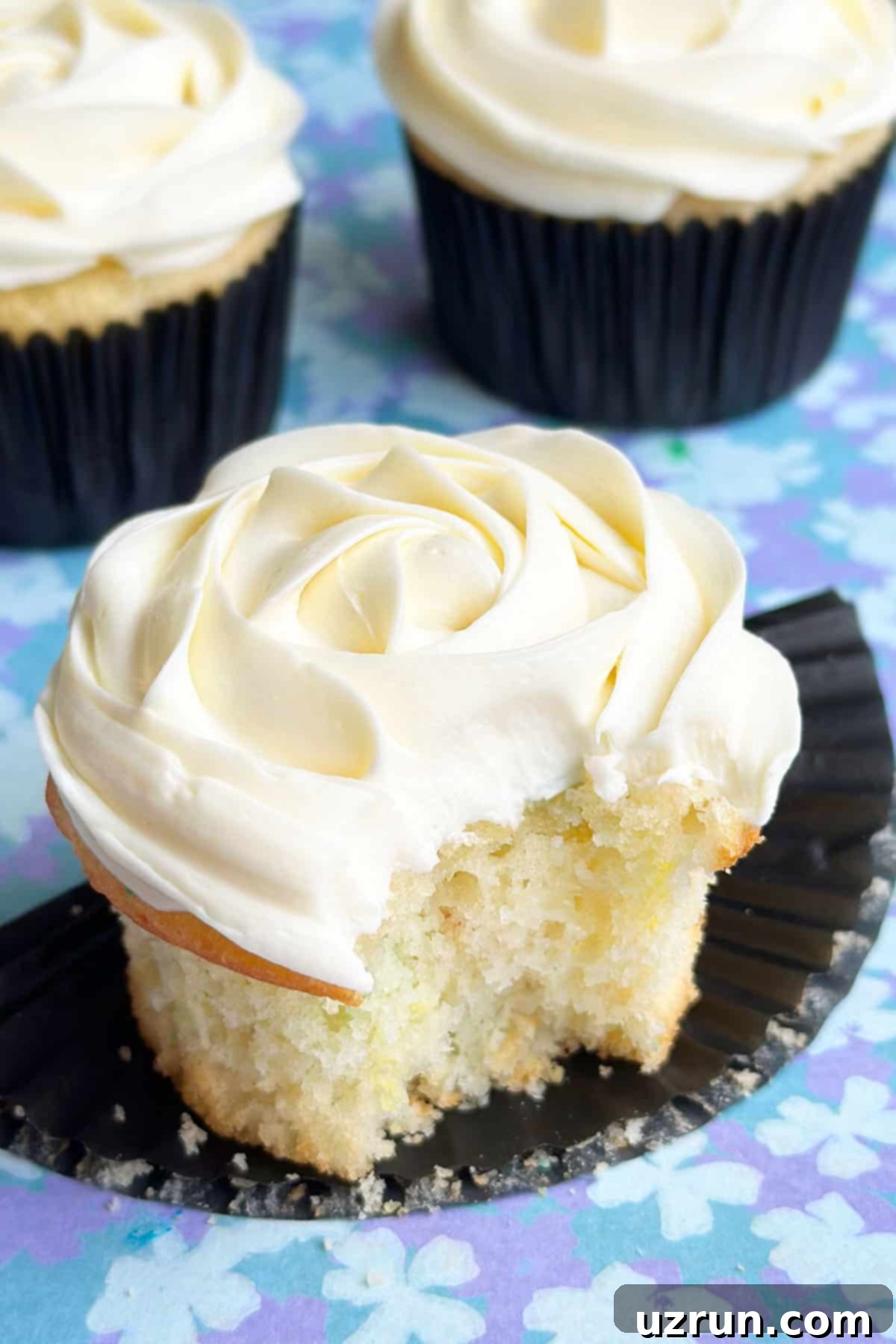
Storage Tips for Almond Cupcakes
Proper storage is key to keeping your homemade almond cupcakes fresh, moist, and delicious for as long as possible. Here’s how to store them, whether frosted or unfrosted:
- Room Temperature (Unfrosted): If your cupcakes are unfrosted, they can be stored in a sealed, airtight container on the kitchen counter for 1-2 days. However, for maximum freshness and to prevent them from drying out, refrigeration is generally recommended, especially for frosted cupcakes.
- Refrigerate (Frosted or Unfrosted): Leftover frosted cupcakes, or unfrosted cupcakes you want to keep fresh for longer, should be stored in a sealed, airtight container in the refrigerator for up to 3 days. To prevent the frosting from getting smudged, you can store them in a single layer or use a container with ample height.
- Freeze (Unfrosted for Best Results): For longer storage, freeze unfrosted cupcakes. Once completely cooled, wrap each cupcake individually in plastic wrap, then place them in an airtight freezer-safe container or freezer bag. They can be stored for up to 1 month. When ready to enjoy, thaw them overnight in the refrigerator or at room temperature, then decorate as desired. Almond buttercream frosting can also be stored separately in an airtight container in the freezer for up to 1 month; thaw in the fridge and re-whip before use.
- Make Ahead: These cupcakes are perfect for making ahead! You can bake the cupcakes up to 3 days in advance and store them, unfrosted, in an airtight container in the fridge. Alternatively, bake and freeze the unfrosted cupcakes and the frosting separately (as described above) for up to 1 month. Allow them to thaw completely, re-whip the frosting if needed, then decorate and serve for a fresh-tasting treat.
More Easy Cupcake Recipes to Try
If you’ve enjoyed making and eating these almond cupcakes, you’re in for a treat! Here are more of our favorite easy cupcake recipes that are just as delightful and perfect for any occasion:
- Best Vanilla Cupcakes
- Carrot Cupcakes
- Coffee Cupcakes
- Yellow Cupcakes
- Blueberry Cupcakes
- Vegan Chocolate Cupcakes
Recipe Card
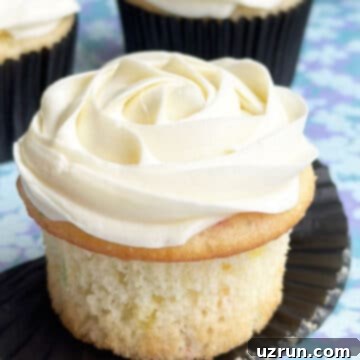
Easy Almond Cupcakes (With Almond Buttercream)
Abeer Rizvi
Pin Recipe
Want to Save This Recipe?
Enter your email & I’ll send it to your inbox. Plus, get great new recipes from me every week!
By submitting this form, you consent to receive emails from CakeWhiz
Ingredients
- 1 Egg Large, ensure it’s at room temperature for better emulsion and a smoother batter.
- ¼ cup Oil Use a neutral-flavored oil like vegetable or canola for optimal moisture and a tender crumb.
- ½ cup Sour cream Full-fat sour cream is highly recommended for maximum richness and moisture; make sure it’s at room temperature.
- ½ cup Water Use warm or room temperature water to help ingredients blend smoothly.
- 1 teaspoon Vanilla extract Pure vanilla extract enhances the overall flavor profile. Use clear vanilla for whiter cupcakes.
- ¼-½ teaspoon Almond extract Almond extract is very strong; adjust amount according to your preference. Start with ¼ tsp and taste. I personally prefer ½ tsp for a pronounced almond flavor. Use clear almond extract for whiter cupcakes.
- 1 ¼ cups All-purpose flour Sifted, to ensure a light and tender crumb. Do not substitute with almond flour.
- 1 cup Granulated sugar White table sugar for sweetness and structure.
- 1 teaspoon Baking powder Ensure it’s fresh for proper rise.
- ½ teaspoon Baking soda Reacts with sour cream for added lift; ensure freshness.
- 2 cups Almond buttercream frosting Homemade almond buttercream is recommended for the best flavor pairing.
Instructions
-
In a large mixing bowl, combine the egg, oil, full-fat sour cream, warm water, vanilla extract, and almond extract. Whisk thoroughly until the mixture is completely smooth and well-incorporated.
-
To the wet ingredients, add the sifted all-purpose flour, granulated sugar, baking powder, and baking soda. Mix on low speed, or by hand, until the dry ingredients are just combined with the wet. A few small lumps in the batter are perfectly fine; avoid over-mixing, as this can make your cupcakes tough.
-
Line a 12-cup muffin tin with paper cupcake liners. Divide the prepared batter evenly among the liners, filling each approximately two-thirds full to allow for proper rising.
-
Preheat your oven to 350°F (175°C). Bake the cupcakes for 18-20 minutes, or until a wooden toothpick inserted into the center of a cupcake comes out clean, indicating they are fully cooked. The tops should be lightly golden.
-
Remove the cupcakes from the oven and let them cool in the muffin tin for about 5 minutes. Then, carefully transfer them to a wire rack to cool completely to room temperature before frosting.
-
While the cupcakes are baking and cooling, take this time to prepare your luscious almond buttercream frosting, ensuring it’s ready for piping once the cupcakes are cool.
-
Once the cupcakes are thoroughly cooled, fill a piping bag fitted with your desired tip (a 1M large star tip creates beautiful roses or swirls) with the almond buttercream icing. Pipe a decorative rose or a generous swirl on top of each cupcake. Serve immediately and enjoy these delightful homemade treats!
Notes
- This recipe can easily be doubled to make 24 cupcakes for larger gatherings or events.
- Remember that almond extract is potent. Adjust the amount based on your preference; a small quantity goes a long way. Since the icing will also contain almond extract, consider the combined flavor intensity.
- Sifting the flour is a crucial step for a light and tender crumb. For best results, sift the flour together with the baking powder and baking soda if you have time.
- Always ensure cupcakes are completely cooled to room temperature before applying frosting to prevent melting.
- For the richest flavor and most moist texture, use full-fat ingredients, especially sour cream.
- All ingredients, particularly eggs and sour cream, should be at room temperature for optimal blending and a smoother batter.
- Avoid over-baking the cupcakes, as this is a common cause of dryness. Start checking for doneness at the minimum suggested bake time.
- Do not over-mix the cupcake batter once the dry ingredients are added; mix only until just combined to prevent tough cupcakes.
- Leftovers can be stored in a sealed airtight container in the fridge for up to 3 days. See the “Storage” section above for more detailed instructions on refrigerating and freezing.
- For additional tips, variations, and troubleshooting advice, please refer to the detailed sections in the article above.
Nutrition
An automated tool is used to calculate the nutritional information. As such, I cannot guarantee the accuracy of the nutritional information provided for any recipe on this site.
